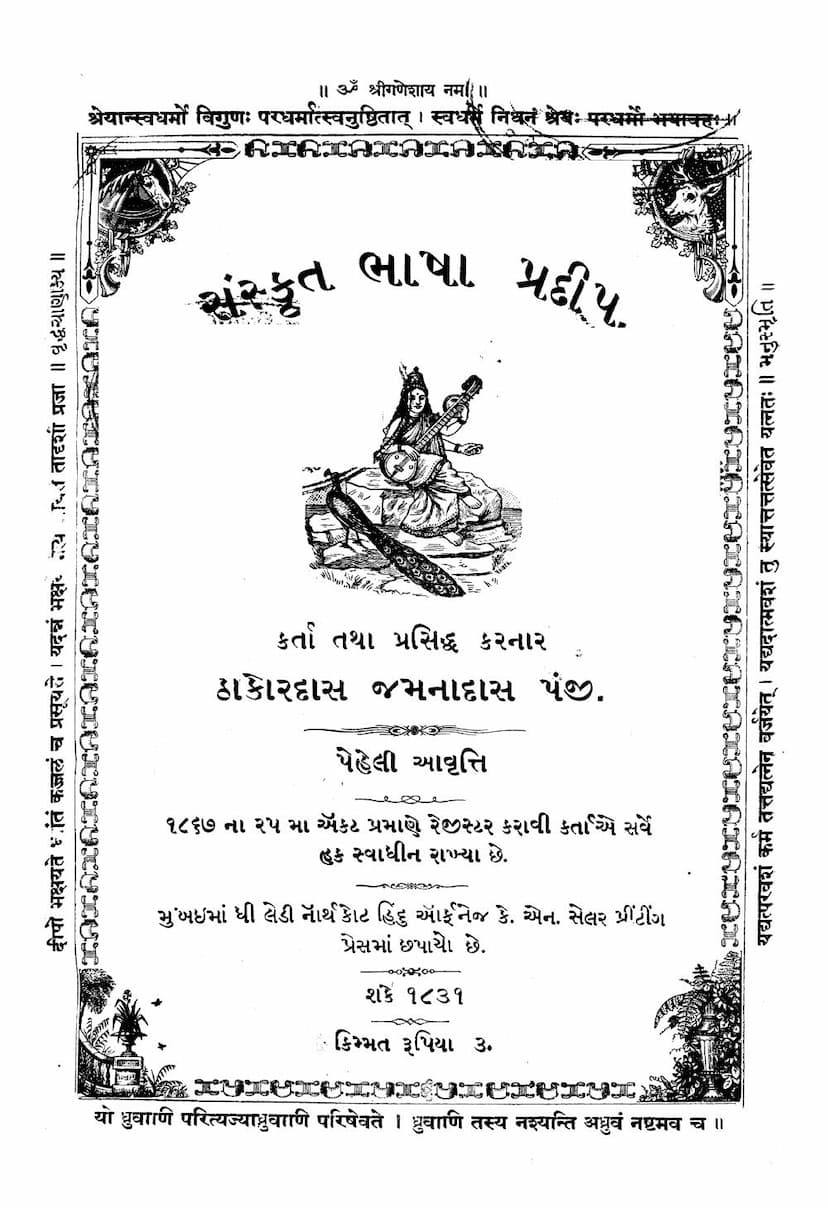Sanskrit Bhasha Pradip
Added to library: September 2, 2025

Summary
Here's a comprehensive summary of the Jain text "Sanskrit Bhasha Pradip" based on the provided pages:
Book Title: Sanskrit Bhasha Pradip Author/Publisher: Thakordas Jamnadas Panji
Overall Purpose and Context:
The book "Sanskrit Bhasha Pradip" (meaning "Lamp of Sanskrit Language") is a Sanskrit grammar guide written in Gujarati by Thakordas Jamnadas Panji. Published in 1867, it aims to make the study of Sanskrit accessible and understandable to Gujarati speakers, particularly those who may not have access to traditional Gurukul learning or find existing resources too difficult. The author's motivation stems from a deep appreciation for Sanskrit's richness and its importance for understanding Indian heritage, as well as personal tragedy (the loss of his son, Chhaganlal, who was to be educated in Sanskrit).
Key Features and Content:
-
Accessibility and Pedagogy: The primary goal is to present Sanskrit grammar in a simple, logical, and accessible way for Gujarati speakers. The author acknowledges the difficulty of Sanskrit and the limitations of existing methods, particularly for younger learners or those without extensive resources. He has meticulously organized the material, breaking down complex topics into manageable parts with clear explanations and examples.
-
Structure of the Book: The book is structured into eight chapters covering essential aspects of Sanskrit grammar:
- Chapter 1: Akshara (Letters): Discusses the origin, details, places of articulation, and effort in producing Sanskrit letters.
- Chapter 2: Sandhi (Sandhi Rules): Elaborates on the rules for combining vowels and consonants, categorizing them into vowel sandhi, consonant sandhi, vowel-consonant sandhi, anusvara sandhi, and visarga sandhi. The author emphasizes the importance of collecting all rules and their exceptions in one place for ease of reference.
- Chapter 3: Dhatu (Roots), Kriyapad (Verbs), Krudanta Avyaya (Verbal Indeclinables), and Krudanta Pradipadik (Verbal Nouns): This is a substantial part of the book, detailing the classification of roots, the formation of various verb forms (tenses, voices), and derivative words. It covers active, passive, and causative formations, as well as various types of participles.
- Chapter 4: Pratipadika (Nouns and Adjectives): Explains the formation of nouns and adjectives, including their gender, case endings, and declensions. It covers adjectives, nouns, pronouns, and gender-specific rules.
- Chapter 5: Avyaya (Indeclinables): Discusses words that do not change form, such as adverbs and particles.
- Chapter 6: Samasa (Compounds): Details the various types of Sanskrit compound words, their formation rules, and rules related to gender and number.
- Chapter 7: Vakya Rachana (Sentence Construction): Explains how to form sentences, including verb conjugation, agreement with the subject in person and number, and the use of different tenses.
- Chapter 8: Parishishta (Appendices): Includes supplementary information such as verb roots (Dhatukosha), the analysis of verb roots (Anubandha), the use of prefixes (Upsarga), and the changes that occur in verbs due to prefixes.
-
Emphasis on Practicality: The author prioritizes making the learning process practical. He has structured the book to build knowledge progressively, starting with letters and sandhi, then moving to roots and verb conjugations, and finally to noun formation, indeclinables, compounds, and sentence construction. The extensive appendices, including a vocabulary of roots and a list of verb forms, are intended to be valuable resources for students.
-
Inclusion of Traditional Knowledge: The book references and explains the established systems of Sanskrit grammar, such as Panini's Ashtadhyayi and Patanjali's Mahabhashya, while also noting later developments and simpler pedagogical approaches like those found in Siddhanta Kaumudi.
-
Personal Dedication: The preface reveals a poignant personal motivation behind the book's creation. The author lovingly dedicates the book to his deceased son, Chhaganlal, who had shown promise in learning Sanskrit. This dedication adds a personal and emotional layer to the scholarly work.
-
Endorsements: The book includes endorsements from various respected scholars, pandits, and educational figures of the time, attesting to its quality, utility, and its potential to make Sanskrit learning more accessible to the Gujarati community. These endorsements highlight the book's clarity, comprehensive coverage, and innovative pedagogical approach.
Key Themes:
- Preservation and Promotion of Sanskrit: The book is a testament to the author's commitment to preserving and promoting the study of Sanskrit, recognizing its cultural and intellectual significance.
- Bridging the Gap: It aims to bridge the gap between traditional, often perceived as difficult, Sanskrit learning and the needs of modern students, particularly in Gujarat.
- Mother Tongue as a Medium: The author champions the use of the mother tongue (Gujarati) as a medium for learning Sanskrit, believing it to be more effective and accessible.
- Diligence and Perseverance: The author emphasizes the value of diligent effort in learning, noting that the study of Sanskrit, while challenging, is ultimately rewarding and contributes to valuable character traits like patience.
In essence, "Sanskrit Bhasha Pradip" is a scholarly yet accessible work intended to democratize the learning of Sanskrit, making its profound knowledge available to a wider audience through the Gujarati language. It represents a significant effort to make classical Indian knowledge relevant and reachable for contemporary Gujarati speakers.